Andy Warhol News 2013
(scroll down)
31 December 2013: Happy Birthday Joe Dallesandro. And a Happy New Year to all. xg.
"We are all Warhol's Children": Andy and the Rusyns
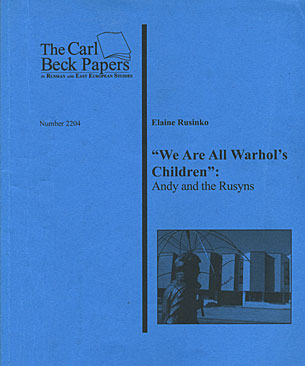
Elaine Rusinko's 90 page treatise, "We Are All Warhol's Children": Andy and the Rusyns, is the most thorough examination of Warhol's Rusyn roots that I have come across in the thirteen or so years I've been researching the artist. This is despite the fact that, as stated in the paper's abstract, "Andy Warhol is the world's most famous American of Carpatho-Rusyn ancestry and the icons of the Ruthenian Byzantine Catholic Church were his first exposure to art."
When Warhol was asked where he came from and he reportedly answered "nowhere," he wasn't far off the mark, given the shifting borders of the Rusyn people. But when and where did Warhol actually say he came from "nowhere?" In what publication or interview? The origination of it is nebulous, like many of the famous sound bites attributed to the artist. Rusinko notes that although the "nowhere" quote is used incessantly in Warhol literature she was not able to find a "direct, primary source for it," although she does mention that Bob Colacello referred to the quote in his 1990 book, Holy Terror, published after Warhol's death. (If there are any Warhol trivia addicts out there who are aware of the primary source of the quote, I'd like to hear from you.)
Different nationalities have claimed Warhol as one of their own. Rusinko notes that the Rusyns "had to wrest Warhol from the Czechs, Slovaks, Poles, Ukrainians, and the Hungarians, who initially laid claim to Andy and his family. Even the catalogue of the New York Museum of Modern Art's 1989 retrospective Warhol exhibit identifies Warhol as 'born of immigrant, Roman Catholic Czech parents.'" In some sources, Warhol is described as talking Czech to his mother but, as Rusinko points out it, wasn't until Warhol "met the Czech model Paulina Porizkova that he commented in his diary, 'I guess maybe I'm not really Czech, because I didn't understand it when they were talking.'"
Although not part of Rusinko's paper, a reviewer of the 2011 exhibition in Prague, "Andy Warhol and Czechoslovakia," clarified the Czech question when he pointed out that the birthplace of Warhol's parents, the village of Miková, was still part of the Austro-Hungarian Empire when Warhol's father, Andrij, emigrated to the U.S. in 1914 and the state of Czechoslovakia had only been in existence for three years when Warhol's mother moved to the U.S. in 1921. The reviewer, Ian Willoughby, concludes that while Warhol's mother, Julia, "was technically 'from' Czechoslovakia, Andrij arguably was not..." (IW) One could argue that neither Warhol's mother nor his father were from Czechoslovakia because Czechoslovakia was not in existence at the time they were born.
The problem is, according to Rusinko, that the Rusyns "have never had their own state," and hence "were always among the poorest peoples of east-central Europe, with an uncertain identity." She notes that about 250,000 Rusyns or 'Ruthenians' as they are sometimes called, emigrated to the U.S. where "their identity... became even more muddled. They spoke East Slavic dialects that used the Cyrillic alphabet, but because they came from a borderland region, their language included admixtures of Slovak, Hungarian, and Polish." Rather than identifying with a state they identified with the Church. Rusinko explains, "They most identified with their religion, Byzantine or Eastern Rite Catholicism, which, like their language and culture, contained elements of both East and West. The Byzantine Catholic Church had a married clergy who observed the liturgy in Old Slavonic and followed the Julian calendar, but they were in union with Rome and recognized the pope as head of their church."
In regard to the importance of religion in Warhol's life, Rusinko notes that "Andy's nephews confirm that before going out for a night on the town, Andy would say a prayer in Slavonic with his mother and receive her blessing..." She also notes that "Andy financed the education of his nephew Paul at a Byzantine Rite Catholic seminary, and when Warhol was shot in 1968 by the radical feminist Valerie Solanas, Father Paul was there to support his uncle in the hospital. He also arranged for him to confess, take communion, and receive the last sacraments from a Greek Catholic priest." Warhol's library contained a number of religious books, including "several versions of the Bible and Qur'an, and a cross hung in the bathroom of the Union Square Factory studio." This is in addition to attending St. Mary's Catholic Church of the Byzantine Rite in New York, attending mass regularly at the St. Vincent Ferrar Roman Catholic Church and serving soup to the homeless during some holidays at the Church of the Heavenly Rest soup kitchen. When Warhol died he was "given a traditional Greek Catholic funeral, with a liturgy that included Rusyn Church Slavonic plainchant, and he was buried next to his parents in St. John the Baptist Byzantine Catholic Cemetery."
Given the extent of his religiosity, one can't help but wonder how Warhol reconciled his homosexuality with the Church's beliefs. To her credit, Rusinko does not ignore the subject of Warhol's homosexuality which is a particularly sensitive subject among the Rusyns. She writes "Not surprisingly, the Rusyns have a hard time with this subject." At one point in her paper she appears to reflect Rusyn attitudes toward homosexuality by pointing out that Warhol could be "just as frustratingly inscrutable about his sexuality as he was about art and ethnicity:"
Elaine Rusinko (from "We Are all Warhol's Children": Andy and the Rusyns):
Was Andy homosexual? To be sure, Warhol was just as frustratingly inscrutable about his sexuality as he was about his art and his ethnicity, dropping enigmatic statements about "fantasy love," "not doing it," and the possibly of marriage (Warhol, Philosophy, 41-46) Most of his associates agree with Bob Colacello's comment: "If one topic was taboo at the Factory, it was Andy's sex life. He wanted - demanded - to know every detail of ours, but his was strictly off limits" (344). So this area of his life also is open to speculation and projection, and it is a point of interest in all the Warhol biographies. Although there are accounts of relationships with several boyfriends, he is most often described as a voyeur, and those who knew him often doubted there was anything physical about Warhol's sexuality.
No mention is made of Warhol's penis and boy drawings of the 1950s or the gay porn found in his time capsules but, as Rusinko notes, there are "accounts of relationships with several boyfriends." And even if it were true that Warhol was only a voyeur, what relevance would that have in regard to the 'gay' issue? Is a heterosexual voyeur still a heterosexual? If so, then a homosexual voyeur remains a homosexual.
Rusinko notes that "almost nowhere in the Rusyn literature on Andy is there any mention of his sexually explicit and homoerotic films. In his book about Warhol, Józef Keselica devotes just one short paragraph to Andy's avant-garde films, indicating that they feature homosexuals and transsexuals, but he rationalizes that Warhol simply filmed everything that was going on around him." The only admission of Warhol's homosexuality that she could find in a Rusyn publication was from an American commentator "who takes advantage of an article on the introduction of the Warhol postage stamp to educate the European Rusyns on tolerance. Jerry Jumba writes, 'It's a fact that can be stated openly. Andy was gay, and that's okay in the United States, where diversity is respected.' He refers to the honour given Warhol and the presence of the mayor of Pittsburgh at the celebration to indicate that Americans accept a gay Warhol, implying that the Rusyns of Europe should do the same." (Although not mentioned in Rusinko's essay, other gay Rusyns include Attilla Kovacs who launched Serbia's first monthly mainstream gay magazine in the autumn of 2011 called Dečko or Pink Yugo.)
It wasn't just Warhol's sexuality that could be problematic from an eastern European point of view. It was also his apparent embracement of capitalism. Rusinko recounts the attempts of Michal Bycko and others to start a Warhol museum in eastern Europe with state officials concerned that "a Warhol museum in the area would be a CIA effort to obtain an outpost in the strategic location" in Slovakia. The museum did eventually open in Medzilaborce on 5 October 1991 and the artwork on display included screen prints of Lenin and Hammer and Sickle which "may have placated the artistically uninformed socialist functionaries who opposed the museum."
There is so much information in Rusinko's paper that it could have easily been developed into a book. It is divided into sections or 'chapters' including four pages of footnotes and a 15 page bibliography, including Rusyn sources. The sections of the paper are:
1. Who Art the Rusyns? Who was Andy Warhol?
2. Was Warhol a Rusyn? The Struggle for Andy
3. Andy Returns to the Homeland of his Parents
4. The Tortuous Road to Warhol City
5. Fifteen Minutes of Fame for Miková
6. Andy's Sexuality
7. Julia's Son, Andy
8. The Myth of the Rusyn Andy
9. Andy Warhol and the American Dream
The paper can be purchased here.
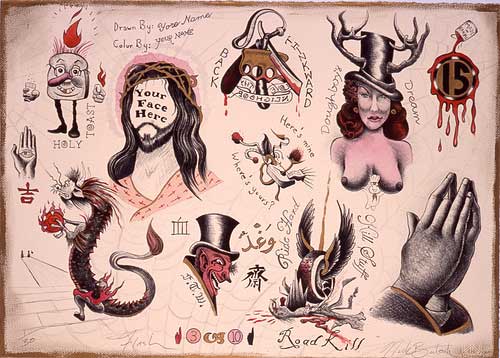
Flash Sheet 15
Handpainted lithograph 22" by 30"/edition of
25
The Nick Bubash exhibition at The Warhol museum opened on 15 June 2013. The 63 year-old Pittsburgh-born artist who dropped out of Penn State University to move to New York City and study under tattooist Thom Devita, describes himself as an "obsessive collector" who uses found objects and imagery to construct his sculptures and artwork. (The picture above comes from his website - here - rather than the exhibition.) Details on his show at The Warhol can be found here.
More on Brubash can be found in an article in the Post-Gazette here.
The Warhol is also featuring an exhibition of work by Genesis P-Orridge who became "Genesis Breyer P-Orridge" after marrying Jacqueline Breyer and has continued to use the amalgam of the name after Lady Jaye, as Jacqueline was known, died in 2007 of stomach cancer. In June 1997, P-Orridge effectively became a millionaire after winning a $1.5 million lawsuit against Rick Rubin and the American Recordings label for injuries incurred as a result of a fire at Rubin's home.
Details on both exhibitions can be found in Art Daily here.
New Harold Stevenson site
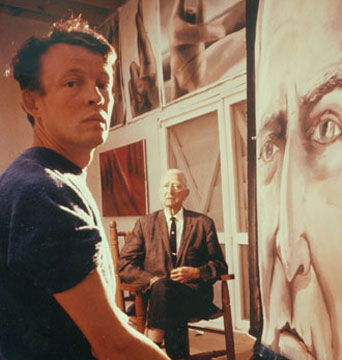
Harold Stevenson, 1967
A new Harold Stevenson site has been started on the web. Stevenson is probably best known for his massive painting, The New Adam, now in the Guggenheim's permanent collection. He was also the subject of a number of films shot by factoryite Danny Williams during the '60s and appeared in the documentary, A Walk Into the Sea: Danny Williams and the Warhol Factory.
The Harold Stevenson website can be found at: here.
Nicky Haslam to release debut album with guest vocals by Helena Bonham Carter and Tracey Emin
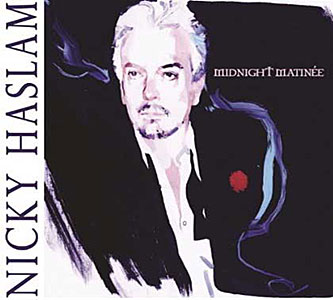
Nicky Haslam's Midnight Matinee
The interior designer and socialite, Nicky Haslam, is releasing an album on 1 July 2013. Haslam, who is over 70 years old, is mentioned in Popism a number of times. Pat Hackett, writing as Andy Warhol, describes Nicky as the person who brought Warhol news of the "mod fashion revolution" in London during the early sixties.
From Popism, p. 27-28:
Nicky had come over from London the year before when his friend, the photographer David Bailey, was bringing his newest model, Jean Shrimpton, over to work for Vogue... It was from Nicky that we first started really hearing about the mod fashion revolution in England that had started in '59 or '60. Nicky may actually have started the frilly men's shirt look because I remember him getting curtain lace at Bloomingdale's and tucking it up his sleeves and everybody would be asking him where he got the 'great shirt' because they'd never seen anything like it.
Nicky Haslam was also the person responsible for introducing Andy Warhol to Baby Jane Holzer:
From Popism, p. 58-59:
This spring of '63 I had met a just-married, twenty-two-year-old beauty named Jane Holzer. Nicky Haslam took me to a dinner at her Park Avenue apartment. David Bailey was there, and he'd brought the lead singer in a rock-and-roll group called the Rolling Stones that was then playing the northern cities of England. Mick Jagger was a friend of Bailey's and Nicky's and he was staying down at Nicky's apartment on East 19th Street at the time.
'We met him when he was Chrissy Shrimpton's maid,' Nicky told me, 'Jean's younger sister. She put an ad in the paper - 'Cleaner wanted' - and up turned Mick. He was a student at the London School of Economics; he was just cleaning flats to pay his way. And then she fell in love with him. We kept telling her, 'But Chrissy, he's so awful looking,' and she'd say, 'Not really.'
The track listing for Midnight Matinee includes Rupert Everett reading "Andy Warhol," Tracey Emin reading her own prose and vocals by Haslam and guest artists such as Cilla Black and Helena Bonham Carter.
Track Listing:
1. Total Control (The Motels) - vocals by Nicky Haslam and David Ogilvy
2. Illusions(Hollander) - vocals by Nicky Haslam and Bryan Ferry
3. Dublin 1919 (Ogilvy) - Bob Geldof reads James Joyce
4. You're Just in Love (Irving Berlin) - vocals by Nicky Haslam and Cilla Black
5. New York 1978 (Ogilvy) - Rupert Everett reads Andy Warhol
6. Real Live Girl (Coleman/ Leigh) - vocals by Nicky Haslam and Sebastian Leon
7. It Never Entered My Mind (Rogers/Hart) - vocals by Nicky Haslam and Cleo Rocos
8. Hollywood 1937 (Ogilvy) Francis Wyndham reads F. Scott Fitzgerald
9. LA 1944 (Ogilvy) - Bob Geldorf
10. How Deep Is The Ocean (Irving Berlin, 1932) - vocals by Nicky Haslam and Sebastian Leon
11. London 1927 (Ogilvy) - Cressida Connolly reads Cyril Connolly
12. Last Man Standing (Guy Chambers) - vocals by Nicky Haslam and Helena Bonham Carter
13. Soliloquy (Ogilvy) Tracey Emin reads her own prose
14. Primadonna (Ogilvy)
15. Mi Va Di Cantare (Buonassissi, Bariero, Valleroni) vocals by Louis Armstrong and Nicky Haslam.
16. Amanda Eliasch Schubert.
17. Delirium Do Rio (Ogilvy) - vocals by João d'Orléans-Braganza, A.N. Wilson, and Nicky Haslam.
(source: Music News)
Andy Warhol's photographs of Gay Pride 1984
Joel Wachs (current president of the Andy Warhol Foundation for the Visual Arts): "In 1984, Andy participated in New York’s Gay Day parade (as they called it then). He took photos, and the pride they displayed then is the pride which we feel today."
Andy Warhol's photographs of the 1984 Gay Pride parade in New York are going to be auctioned by Christie's this month as part of their online auction of work by the artist. Details of the auction can be found here. (Please note the "explicit content" warning that appears on the first page of the site saying that you must be over 18 to access it.)
Andy Warhol weekend at MassMu
A weekend of Warhol related events will be kicking off the "Snap! Warhol" exhibition at the Massillion Museum (aka MassMu) which opens on 22 June. On the night of 21 June there will be a Studio 54 style Disco Ball where "platforms and polyester" are encouraged and a vintage photobooth will be available. On the 22nd there will be a free opening reception with the band, Pale Blue Eyes, performing songs by The Velvet Underground.
Sponsors of the exhibition are the Ohio Arts Council, The Repository, William A. & Ann Brothers Charitable Fund, Arts in Stark, Inis Maggiore ad agency, Canton Stark County, Day Ketterer (attorneys-at-law), Shearer's, Akron-Canton airport, Fishers Foods, Greif Packing, MCTV, Yund's Busy Bee Car Wash and JW Color.
Sponsors of the Disco Ball are Fresh Mark, Inc., Massillon Plaque Company, Farmer’s National Bank, Bob and Nancy Gessner, Cyrus Custom Framing, Elum Music Company, Gasser Fine Jewelers, Krugliak, Wilkins, Griffiths & Dougherty Co., LPA Quonset Hut, Robert Garner Agency State Farm Insurance, Robert J. Events and CateringAD.
Details here.
Andy Warhol's Rusyn roots
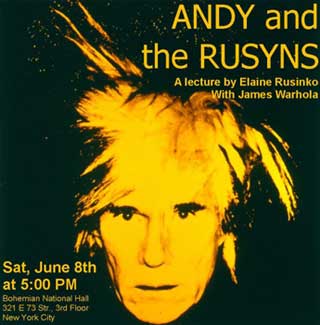
Andy and the Rusyns flyer
Andy Warhol's nephew, James Warhola, and Elaine Rusinko, Ph.D will be discussing Andy Warhol's Rusyn roots on Saturday 8 June at the Bohemian National Hall in New York. The event is being organized by the Czechoslovak Society of Arts and Sciences NY in cooperation with the Carpatho-Rusyn Society, New York Chapter, and the Consulate General of the Slovak Republic in New York.
In addition to being Warhol's nephew, James Warhola is an award winning illustrator and the author of two children's books about his uncle - Uncle Andy: A faabbbulous visit with Andy Warhol and Uncle Andy's Cats. Rusinko is author of the monograph We are all Warhol's children: Andy and the Rusyn.
Details on the talk can be found on the website of the Czechoslovak Society of Arts & Sciences here or on their Facebook page at: here.
Pat Hackett exhibition at the Ogunquit
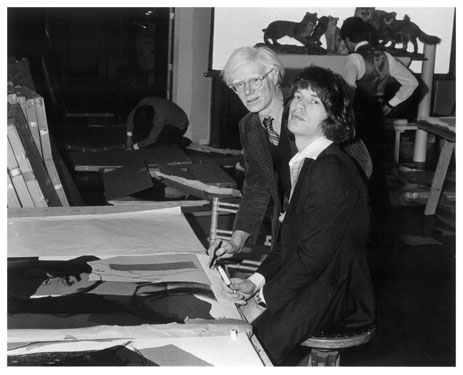
Andy Warhol signing his portrait of Mick Jagger of The Rolling Stones
(Photo: Pat Hackett)
Warhol's secretary and co-writer, Pat Hackett, will be exhibiting a selection of her photographs of the artist from 14 July to 1 October 2013 at the Ogunquit Museum of American Art in Maine. Hackett is credited as the co-author of Popism and also edited The Andy Warhol Diaries. As Warhol's secretary she was privy to his working methods - below she describes his process for making portraits. Although Warhol is sometimes characterised as an artist who simply farmed out his work to others, Hackett's description reveals an elaborate process that involved a hands-on approach by the artist. Silk screening was just one of the techniques involved.
Pat Hackett:
Andy's procedure for making a portrait was elaborate. It began with the subject posing while he took approximately sixty Polaroid photos... Then, from those sixty shots he would chose four and give them to a screen printer (he worked exclusively with one printer at a time - before 1977, his silkscreener was Alex Heinrici; after that, it was Rupert Smith) to make positive images on 8" x 10" acetates. When those came back to him he would choose one image, decide where to crop it, and then doctor it cosmetically in order to make the subject appear as attractive as possible - he'd elongate necks, trim noses, enlarge lips, and clear up complexions as he saw fit; in short, he would do unto others as he would wish others to do unto him. Then he would have the cropped, doctored image on the 8"x10" blown up to a 40" by 40" acetate, and from that the screen printer would make a silkscreen.
To always be prepared for the steady stream of portraits, Andy had his assistants pre-paint rolls of canvas in one of two background shades: flesh tone for men's portraits and a different, pinker, flesh tone for women's. Using a carbon transfer under tracing paper, he'd trace the image from the 40" x 40" acetate onto the flesh-tone-painted canvas and then paint in the coloured areas like hair, eyes, lips on women, and ties and jackets on men. When the silkscreen was ready, the detailed image would be lined up with the pre-painted coloured areas and the details for the photograph would be screened onto the canvas. It was the slight variations in the alignment of the image with the painted colours underneath that gave Warhol portraits their characteristic 'shifting' look. The portraits, as a rule, cost approximately $25,000 for the first canvas and $5,000 for each additional one. (AWDxvi)
A slideshow of her work can be found here.
Further details on the exhibition can be found on the museum's website here.
Lou Reed is recovering from a liver transplant
Billboard magazine has revealed that 71 year-old Lou Reed has had a liver transplant. They quote his wife, Laurie Anderson, as saying that Reed "was dying" before he had the operation and commenting that she doesn't "think he'll totally recover from this, but he'll certainly be back to doing (things) in a few months."
Warhol discovered Reed and The Velvet Underground in December 1965 and produced their first album. (See: here.)
The Billboard article can be found here.
Andy Warhol Foundation settles out of court with The Velvet Underground
The Andy Warhol Foundation has settled a lawsuit that The Velvet Underground brought in relation to the banana illustration which graced the cover of their first album, produced by Warhol. News of the original complaint can be found in the January 2012 news here (scroll down). The terms of the settlement have not been disclosed.
Taylor Mead memorial
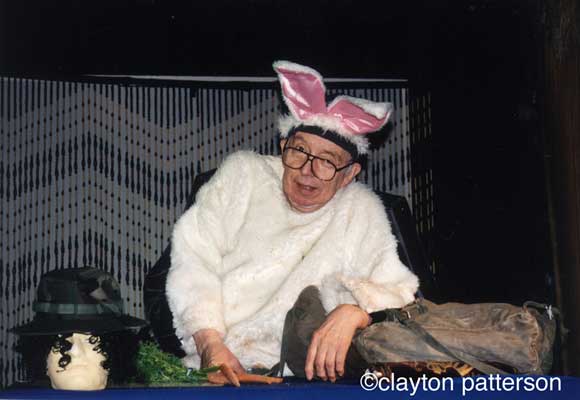
Taylor Mead dressed as a rabbit for a theatrical production
(Photo: Clayton Patterson)
A memorial for Warhol star Taylor Mead was held at the Bowery Poetry Club on Monday 13 May 2013. Playwright Robert Heide has contributed a report on the memorial which you can find here.
Prior to his death, Mead performed regularly at the Bowery Poetry Club "thanks to the generous financial support of the Andy Warhol Foundation."
Holly Woodlawn to do reading at LGBT Centre in New York on Thursday
In addition to the two dates at the Laurie Beecham Theatre in New York (see below), Holly Woodlawn will also be doing a reading at the LGBT Centre of her autobiography, A Low Life in High Heels, on Thursday 16 May. Details at: here.
R.I.P. Taylor Mead
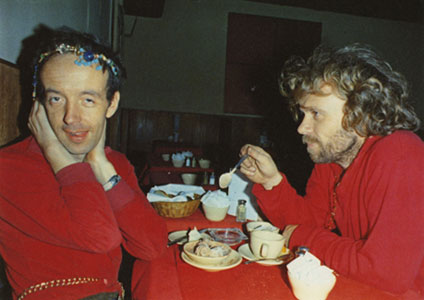
Taylor Mead (L) with Louis Waldon
(Photo: Billy Name)
Billy Name: "Taylor Mead was a great slapstick comedian - sort of a combination of Charlie Chaplin and Harry Langdon. He will be missed; a star from the ground joins the stars in the heavens."
As many of you will know by now, the legendary Warhol star Taylor Mead died on 8 May 2013 in Colorado after suffering a stroke. His family has contributed an obituary which you will find here. R.I.P. Taylor.
Warhol: Immortal at Te Papa Tongarewa
"Warhol: Immortal" opens at the Te Papa on 1 June and runs until 25 August 2013. In case you don't speak Māori, details of the exhibition in English can be found here.
The Store at MoMA
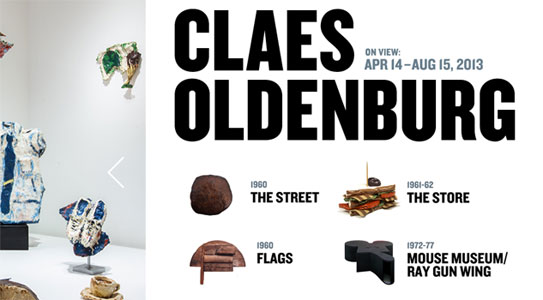
The Store and The Street at the Museum of Modern Art
An exhibition based on Claes Oldenburg's "The Store" opened on 14 April at the Museum of Modern Art in New York and continues until 15 August. "The Store" was one of the exhibitions in New York that, according to Warhol's friend Ted Carey, caused Warhol to become frustrated at not being part of the new art that was being produced at the time. The frustration led to the Campbell's Soup Can paintings. Earlier in the year Warhol had exhibited his paintings based on comic strips and ads in a window display at the Bonwit Teller department store.
Ted Carey:
... at that time, Leo [Castelli] was not interested in taking Andy on: so, Andy didn't get in there. Lichtenstein was being shown by Castelli, which was, like, the Pop gallery - Lichtenstein was going to get the credit. So, all of these paintings that Andy done, even if they had been done and had been recognized as being done before Lichtenstein were, really, going to be anti-climatic. And, I remember that right about this time that Oldenburg was having an exhibition downtown in The Store - it was a fabulous store. He just rented a store and just did the whole store in cakes, pies... I mean, it was incredible. And going down there with Andy, and it was just overwhelming and so fabulous that Andy was depressed. He said, 'I'm so depressed.'
... after going to the Oldenburg Store, I called him [Warhol] when I got home, and I said that... John [Mann], Muriel [Latow] and I are having dinner tonight. Do you want to have dinner with us?' And he said, 'No, I'm just too depressed'.... So, after dinner we went to Andy's and he was very depressed. and Muriel was depressed because she was either, at the time, declaring bankruptcy or was about to declare bankruptcy... Andy said ,'I've got to do something.' He said, 'The cartoon paintings... it's too late. I've got to do something that really will have a lot of impact that will be different enough from Lichtenstein and Rosenquist, that will be very personal, that won't look like I'm doing exactly what they're doing.' And he said, 'I don't know what to do.' 'So,' he said, 'Muriel, you've got fabulous ideas. Can't you give me an idea?' And so, Muriel said - she said, 'Yes.' 'But,' she said, 'it's going to cost you money.' So Andy said, 'How much?' So she said 'Fifty dollars' [approximately $389 in today's terms]. And Andy ran and got his checkbook, like, you know, he was really crazy, and he wrote out the check, and he said, 'All right. Give me a fabulous idea.' And so, Muriel said, 'What do you like more than anything else in the world?' So Andy said, 'I don't know. What?' So she said, 'Money. The thing that means more to you and that you like more than anything else in the world is money. you should paint pictures of money.'
And so Andy said, 'Oh, that's wonderful.' So, then, either that, or, she said, 'you've got to find something that's recognizable to almost everybody. Something you see everyday that everybody would recognise. Something like a can of Campbell's Soup.' So, Andy said, 'Oh that sounds fabulous.' (PS255-257)
The exhibition at MoMA also includes Oldenburg's The Street, a previous installation that took place at the Judson Gallery.
Claes Oldenburg Links
Claes Oldenburg and Andy Warhol Pre-Pop here.
The Store in the AbEx Chronology here.
The Street at the Judson Gallery here.
An examination of Carey's comments and other reasons that Warhol might have painted soup cans are included in "The Origin of Andy Warhol's Soup Cans or The Synthesis of Nothingness" here.
The Cardiff theatrical group, Earthfall, is presenting a production based on the Chelsea Hotel and its historical inhabitants on 23 April at the Torch Theatre, Milford Haven and on 27 April at Theatr Brycheiniog, Brecon, in advance of a UK tour. The inspiration for the play apparently comes from an earlier Warhol-related production performed by the group. Co-director Jessica Cohen has been quoted on Walesonline as saying "We previously did a show based on Andy Warhol’s Silver Factory, which was his first factory space in Manhattan... While we were researching for that show, we kept coming across references to the Chelsea Hotel."
Details of the production can be found at: here (in Welsh).
Recommended
Two exceptionally good Warhol-related books that have come out in the past year are the English version of Andy Warhol and Czechoslovakia by Rudo Prekop and Michal Cihlář and The Inevitable World of The Velvet Underground by Alfredo Garcia.
The authors of Andy Warhol and Czechoslovakia were involved in the founding of the Warhol Museum of Modern Art in the eastern Slovakian town of Medzilaborce. Prekop is a well-known photographer in Czechoslovakia and Cihlář is a Czechoslovakian artist.
The author of The Inevitable World of The Velvet Underground, Alfredo Garcia, previously helped with the photo research for The Velvet Underground & Nico 45th Anniversary Super Deluxe 6CD Box Set and the Velvet Underground: The Verve/MGM 5 LP Deluxe Box Set. Comments by people who have purchased Garcia's book can be found here.
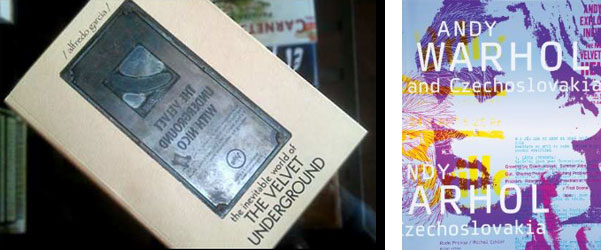
Left: The Inevitable World of The Velvet Underground/Right: Andy Warhol and Czechoslovakia
Both books are compilations of sorts. One is a selection of interviews of Warhol's relatives and work colleagues and the other is a catalogue of ads and articles about the Velvet Underground which is loaded with so much Warhol content that it more than qualifies as a Warhol book.
The Inevitable World of The Velvet Underground gives the reader access to the actual press reports and ads from the Warhol/Velvets era, including rare articles from the underground press which are not picked up by research databases such as Proquest - small newspapers like The Electric Frog, The Avatar, The Buddhish Junkmail Oracle, and the LongHair Times (UK) . For instance, the section of the book devoted to Warhol's trip to L.A. for performances of the E.P.I. includes the often quoted Variety article giving the reasons for the closure of the nightclub at which the Velvets were performing but also includes a review of the performance from the underground publication, the Los Angeles Free Press:
Paul Jay Robbins (Los Angeles Free Press, 13 May 1966):
Andy Warhol, a basically other-made man, is the spotlit mouth that created a creature called Pop. Since 1962, his gratis but lucrative campaign for Campbell's Soup and other cultural negations has propelled him forward if not upwards.... Warhol (and I use the word only to describe his products, not his personality) passed from art to advertising to anti-art to anti-film; he has now broken clean on a familiar field of anti-all... About a year ago, Warhol became intrigued with rock & roll and collected unto himself an assemblage of musicians called the Velvet Underground. Him, they, a chick [by the] name of Nico, a matched pair of morbid dancers, and a clutch of camp followers, all come together in a show called the Plastic Inevitable. It's all at the Trip on Sunset Strip till May 18.
The journalist then goes on to review the show (referring to Nico as mitigating "the impending collapse of sanity primarily because of her ineptitude as a singer"), and concludes that the performance " was a catharsis and an enlightenment." When he left the venue he felt he "had come through an intense spatter of nihilism - the peculiar brand of it so fashionable in New York circles..." The west coast hippies considered the scene in New York as fashionable nihilism.
The Warhol-related ads and articles in the book are not limited to Velvet concerts, but also includes film screenings and other events such as the "National Swingers Nite" at the Gymnasium as per the photo below.
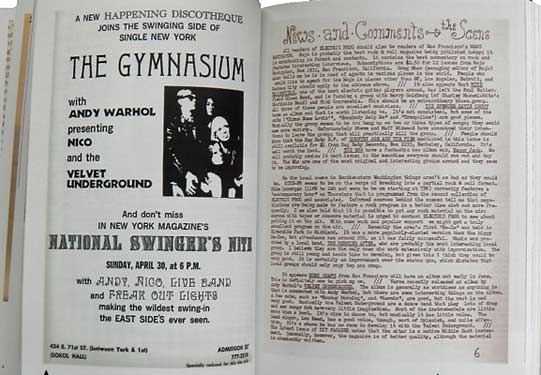
from The New York Guide to the Swinging Side of Single New York, Vol. 1, no. 18, April 1967, as reproduced in The Inevitable World of The Velvet Underground
Also included is ephemera relating to the Ann Arbor festival, Warhol's trip to San Francisco, the performances at Poor Richards in Chicago, The Chelsea Girls screenings, the ICA exhibition, the mod wedding in Detroit - the list could go on and on. One newspaper reviewer of the TV program USA: Artists quotes Warhol as saying that although he's given up painting, he is still doing sculpture "to make a painting that floats." Another interesting item is the account of Allen Midgette impersonating Warhol from a 1968 issue of the Tuscalosa News:
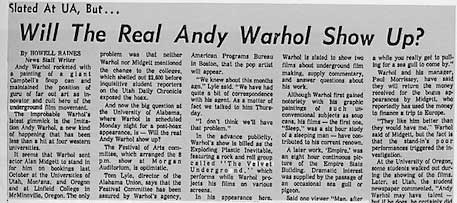
from The Inevitable World of The Velvet Underground
Just as The Inevitable book is advertised as a Velvets catalogue but contains quite a bit on Warhol, the Andy Warhol and Czechoslovakia book is advertised as a Warhol book but also contains quite a bit on the Velvets, including the Czech tour of "Mo Tucker's Band;" interviews with Sterling Morrison, John Cale, Lou Reed (and accounts of his Czech performances); an interview with Nico's son Ari Boulogne ("I was allowed to climb on Andy's knee. And Andy didn't like it if other people touched him"); and accounts of Nico's Czech performances, including her 1985 performance in Opatov, Prague - some of which was filmed for a Czech TV series, Bigbit:
Vojtěch Lindaur (promoter of the Nico concert at The House of Culture Opatov, Prague):
Nico was terribly exhausted when she arrived, high, well, with not much left to get high on. So she was in a bad state about it. She shut herself in the dressing room. I had the privilege of being allowed to take her her vodka and juice there. Three fingers of juice to a litre of vodka. She was smoking one joint after another, so as to get at least SOMETHING out of herself...
Later, when the concert was over, someone at the back told her that the secret police were there. She had grass with her, and maybe a bit of cocaine. She was smoking it there on the stage, openly. I think her manager Nick told her when she finished the gig. She panicked and ran away - down the ramp to the drugstore, and hid there. She squatted there in the corner like a little heap of misery...
The book is also full of the reminiscences of Warhol's relatives, many of whom visited him in New York:
Nora Zavacky (Andy's cousin):
I knew Andy from childhood in Pittsburgh and I have this picture from him. He asked me what he could give me and I chose this one. It was some time in 1953 in New York on Lexington Avenue. I was in new York with two girlfriends from Pittsburgh. We were staying in a hotel and my friends couldn't think of anything except how to meet boys. I got fed up with it so I called Aunt Júlia. And she said, 'Come round to our place. I'll make chicken soup.' So I went round and Andy was there too...
That evening Andy wanted to show me me the city. He asked me if I liked ballet - he wanted to go to one that day and asked if I'd like to accompany him. I agreed. We went to Greenwich Village. For a while we just walked around and then it was the start of the performance... I was bored, because those dancers and what they were doing were very strange. It made no sense to me. But Andy was in ecstasies. 'Wow, that's wonderful! Aren't the dancers beautiful'
When the ballet was over we walked around a bit more... 'Do you like strong coffee?' he asked. 'Sure' I said. So we went to have some. At the entrance to the bar Andy told me I should wiggle my hips a little. That seemed weird to me. There were a lot of sailors, boys from the transatlantic ships in flat caps... 'Please, why was I supposed to wiggle my my behind?' I asked him. 'So no one here will think you don't belong here,' he told me.
And here is another cousin who visited Warhol three times - in 1976, 1984 and 1986:

from Andy Warhol and Czechoslovakia
Christine (Zavacky) Soley:
I went to see him at the Factory. It was a Saturday and no one was working there except Andy. He was completely on his own. He showed me the Factory, and explained how the silk-screen printing was done. He let me photograph it all. I looked at his pictures and he gave me some magazines, which he signed for me. And he also gave me a print of cows and a print of Chairman Mao. We talked about going to China, which we had both visited at the time. He talked a lot about his mother. At the end of her life she was sick, and he had to put her in an institution because he couldn't look after her at home. he wanted to be reassured that he was doing the right thing....
But were Warhol's roots Czechoslovakian? Warhol's parents came from Miková which was part of Ruthenia but the boundaries of Ruthenia changed often. Paul Robert Magocsi clarifies the situation on the "everyculture" website at: here.
Paul Robert Magocsi ("Carpatho-rusyn Americans/Overview"):
Carpatho-Rusyns (also known in English as Ruthenians) come from an area in the geographical centre of the European continent. Their homeland, known as Carpathian Rus' (Ruthenia), is located on the southern and northern slopes of the Carpathian Mountains where the borders of Ukraine, Slovakia, and Poland meet. Carpatho-Rusyns have never had their own state and have lived since the sixth and seventh centuries as a national minority, first in the kingdoms of Hungary and Poland, then from the late eighteenth century to 1918 in the Austro-Hungarian Empire. Since the end of World War I, borders have changed frequently, and Carpatho-Rusyns have found themselves living in several different countries: from 1919 to 1939 in Czechoslovakia and Poland; during World War II in Hungary, Slovakia, and Nazi Germany; and from 1945 to 1989 in the Soviet Ukraine, Czechoslovakia, and Poland.
As one reviewer of the exhibition linked to the book has written, "The birthplace of Warhol’s parents, the village of Miková, was still part of the Austro- Hungarian Empire when his father Andrij Warhola, like many Ruthenians, emigrated to the US in 1914, shortly before the outbreak of the First World War. The state of Czechoslovakia — created after the dissolution of the Austro-Hungarian empire — has [sic] been in existence for only three years when Julia [Andy's mother] followed Andrij to America in 1921. So while Julia was technically 'from' Czechoslovakia, Andrij arguably was not..."
As with the Inevitable catalogue there is so many interesting tidbits in the Czechoslovakia book that it's difficult to chose just a few examples - I loved all the never-before published snapshots such as Billy Name holding up his own Warhol portrait. Billy is interviewed twice in the book. He also interviews Henry Geldzahler by telephone (in 1993). There are also interviews with Paul Morrissey ("...thanks to those films I learned how to choose actors better and direct them in a different way"); Gerard Malanga, Leo Castelli, Taylor Mead, Jamie Wyeth, Ultra Violet ("I saw photos of Andy what he was eighteen and he was a really handsome boy. That's true. I think he got uglier when he became a homosexual."); Christopher Makos, Vincent Fremont and others.
The Inevitable book costs $135 and is only being published in a limited edition. Given the quality of the publication, the amount of time and effort put into it by Garcia, and that it includes a CD of rarities, it's well worth the price. A track listing for the CD can be found here.
The list price of Andy Warhol and Czechoslovakia is $95.
The website for The Inevitable World of the Velvet Underground can be found here.
The building in which the Soup Cans were created is being sold
Warhol's townhouse at 1342 Lexington Avenue in New York is being sold for $5.99 million. This is the home where the original Campbell's Soup Can paintings were painted (beginning in c. December 1961). This included the Ferus-type Soup Cans, the Mönchengladbach-type Soup Cans and the serial Soup Cans.
But it wasn't just the Soup Cans that Warhol painted at that address. Many of his earliest and well-known Pop paintings were created there between late 1961 through 1962. He didn't have a separate studio until he rented an old fire station in November 1962 which he probably moved into in early 1963. In addition to the Campbell's Soup Can paintings, the paintings produced at 1342 Lexington include:
Advertisement paintings
Before and After paintings
Comic strip paintings
Newspaper advertisment paintings (including Icebox)
Consumer product paintings (such as Typewriter and Telephone)
Coca Cola paintings
Dance Diagram paintings
Dollar Bill paintings
Trading stamps and postage stamp paintings
Do It Yourself paintings
News headline paintings
Label paintings (such as shipping and coffee labels)
Car paintings
Teen Stars (including Natalie Wood, Warren Beatty and Tab Hunter)
Troy Donahue
Marilyn Monroe
Early Elvis paintings
Robert Rauschenberg portraits
Early Elizabeth Taylor paintings
Optical paintings
Early suicide paintings
A list of his New York addresses and the approximate years he lived at them are below:
1949: Sublease at St. Marks and Avenue A with Philip Pearlstein.
1949- April 1950: After sublease was up, they moved into Franziska Boas' apartment at 323 W. 21 Street. (evicted April 1950)
April 1950 - evicted from Boas. Moved into 74 West 103rd Street by August.
From November 1950 lived for a 'few months' with Joseph Groell at 25th Street between First and Second Avenue.
By June 1951: Lived in flat registered to Victor Reilly at 218 East 75th Street.
1952: Rented accommodation on 216 East 75th Street. Mother moved in with him.
1953: Moved to 242 Lexington (between 33 and 34th St.).
30 August 1960: Moved into 1342 Lexington Avenue - 89th and Lexington.
Early 1974: Buys a six story brownstone at 57 East 66th Street between Madison and Park Avenues, paying $310,000 outright. Fred Hughes moved into Warhol's old house on Lexington Avenue at 89th Street. Vincent Fremont moved into Fred's old apartment on East 16th Street.
Warhol's other real estate holdings at the time of his death included his compound in Montauk (co-owned with Paul Morrissey) and the property on Great Jones Street where Jean-Michel Basquiat died from an overdose of heroin. (It was at the Montauk compound that the non-Warhol movie, Cocaine Cowboys was filmed. Warhol appears in the film briefly.)
The above list does not include Warhol's studios/offices. He worked from home until 1963. He rented a disused firehouse to use as a studio from about November 1962 and moved to the Factory in early 1964. In 1968 he moved his operations to 33 Union Square West and in 1974 to 860 Broadway. In December 1984 Warhol purchased his final studio/offices - the old Con Edison building on Madison Avenue between 32nd and 33rd Streets. The Con-Ed building was the only studio that he actually owned. The previous ones were leased.)
A New York Times article about the sale of 1342 Lexington can be found here.
Holly Woodlawn's New York gig to be filmed for upcoming documentary
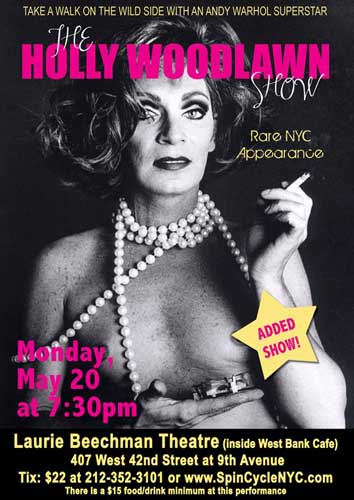
Warhol star Holly Woodlawn, one of the characters mentioned in the Velvets' song Walk on the Wild Side, has added a night to her upcoming performance in New York after the first night was sold out. The gig will be filmed for a documentary on Holly currently in production. Details and tickets here.